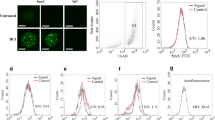Summary
Anti-fluorescein antibodies were found to prevent the fading of emitted fluorescence from fibroblasts stained with fluorescein-labelled fibronectin antibodies. The prevention of fading is the result of specific binding of the fluorochromes present on the stained cells by the anti-fluorescein antibodies. The sheep anti-FITC antibody used in this study was equally effective in preventing the fading of both FITC-and carboxyfluorescein-labelled fibronectin antibodies. The method is simple, effective, does not interfere with the primary immune reaction, and in addition to preventing the fading of fluorescence it reduced the background fluorescence of the specimens. The procedure is expected to make an important contribution to improving the quality of fluorescence immunohistochemical techniques used in diagnosis.
Similar content being viewed by others
References
Anderson, G. W., Zimmerman, J. E. &Callahan, F. M. (1964) The use of esters ofN-hydroxysuccinimide in peptide synthesis.J. Amer. Chem. Soc. 86, 1839–42.
Bock, G., Hilchenbach, M., Shauenstein, K. &Wick, G. (1985) Photometric analysis of antifading reagents for immunofluorescence with laser and conventional illumination sources.J. Histochem. Cytochem. 33, 699–705.
Cinader, B. (1976) Enzyme-antibody interactions.Meth. Immunol. Immunochem. 4, 313–75.
Freshney, R. I. (1983)Culture of Animal Cells. A Manual of Basic Technique. New York: Alan R. Liss.
Fukuda, M., Tsuchihashi, Y., Takamatsu, T., Nakanishi, K. &Fujita, S. (1980) Fluorescence fading and stabilization in cytofluorometry.Histochemistry 65, 269–76.
Gill, D. (1979) Inhibition of fading in fluorescence microscopy of fixed cells.Experientia 35, 400–1.
Giloh, H. &Sedat, J. W. (1982) Fluorescence microscopy: reduced photobleaching of rhodamine and fluorescein protein conjugates byn-propyl gallate.Science 217, 1252–5.
Jobbagy, A. &Kiraly, K. (1966) Chemical characterisation of fluorescein isothiocyanate-protein conjugates.Biochem. Biophys. Acta 124, 166–75.
Johnson, G. D. & deC Nogueira Araujo, G. M. (1981) A simple method of reducing the fading of immunofluorescence during microscopy.J. Immunol. Meth. 43, 349–350.
Johnson, G. D., Davidson, R. S., McNamee, K. C., Russell, G., Goodwin, D. &Holborow, E. J. (1982) Fading of immunofluorescence during microscopy: a study of the phenomenon and its remedy.J. Immunol. Meth. 55, 231–42.
Johnstone, A. &Thorpe, R. (eds) (1987)Immunochemistry in Practice. 2nd edn. p. 292. Oxford: Blackwell Scientific Publications.
Lopatin, D. E. &Voss, E. W. Jr, (1971) Fluorescein. Hapten and antibody active-site probe.Biochemistry 10, 208–13.
McKinney, R. M., Spillane, J. T. &Pearce, G. W. (1964) Determination of purity of fluorescein isothiocyanates.Anal. Biochem. 7, 74–86.
Nargessi, R. D. &Landon, J. (1981) Indirect quenching fluoroimmunoassay.Meth. Enzymol,74, 60–79.
Picciolo, G. L. &Kaplan, D. S. (1985) Reduction of fading of fluorescent reaction product for microphotometric quantitation.Adv. Appl. Microbiol 30, 197–235.
Riggs, J. L., Seiwald, R. J., Burckhalter, J. H., Downe, C. M. &Metcalf, T. G. (1958) Isothiocyanate compounds as fluorescent labelling agents for immune serum.Am. J. Path. 34, 1081–98.
Rodriguez, J. &Deinhardt, F. (1960) Preparation of a semipermanent mounting medium for fluorescent antibody studies.Virology 12, 316–7.
Samuel, D., Patt, R. J. &Abuknesha, R. A. (1988) A sensitive method of detecting proteins on dot and Western blots using a monoclonal antibody to FITC.J. Immunol. Meth. 107, 217–24.
Sedlacek, H. H., Grigat, H., Renk, T. &Seiler, F. R. (1981) The fluorescence immunoassay using plane surface solid phases (FIAPS).Meth. Enzymol. 74, 87–105.
The, T. H. &Feltkamp, T. E. W. (1970) Conjugation of fluorescein isothiocyanate to antibodies. I. Experiments on the conditions of conjugation.Immunology 18, 865–73.
Valnes, K. &Brandtzaeg, P. (1985) Retardation of immunofluorescence fading during microscopy.J. Histochem. Cytochem. 33, 755–61.
Voss, E. W., Jr. (ed) (1984)Fluorescein Hapten: an Immunological Probe. pp. 1–20. Boca Raton, Fl: CRC Press.
Wick, G., Hengster, P., Bock, G. &Dierich, M. P. (1988) Improvement of immunofluorescence for diagnosis of AIDS using laser microscopy.J. Histochem. Cytochem. 36, 793–6.
Author information
Authors and Affiliations
Rights and permissions
About this article
Cite this article
Abuknesha, R.A., Al-Mazeedi, H.M. & Price, R.G. Reduction of the rate of fluorescence decay of FITC- and carboxyfluorescein-stained cells by anti-FITC antibodies. Histochem J 24, 73–77 (1992). https://doi.org/10.1007/BF01082442
Received:
Revised:
Issue Date:
DOI: https://doi.org/10.1007/BF01082442




